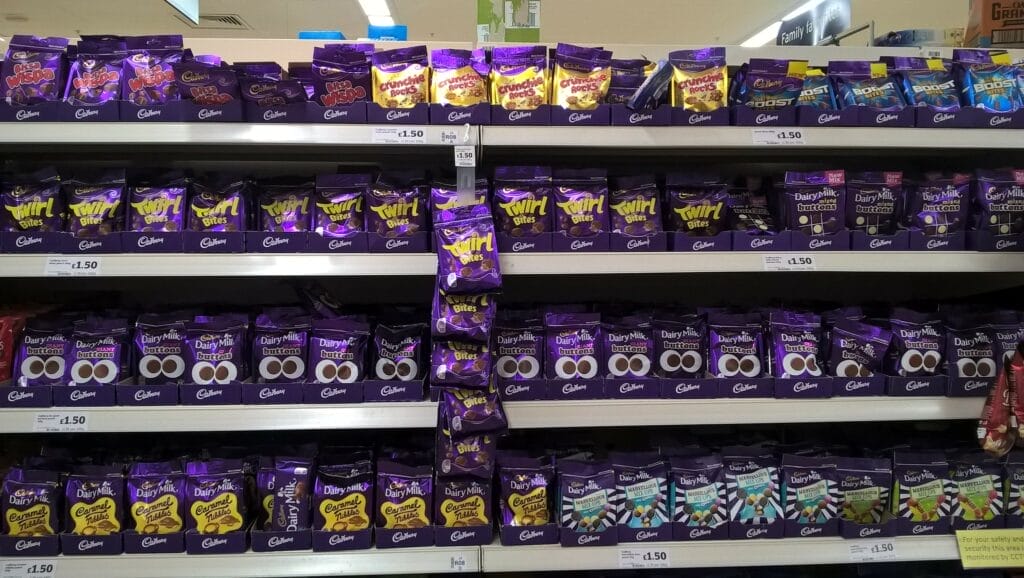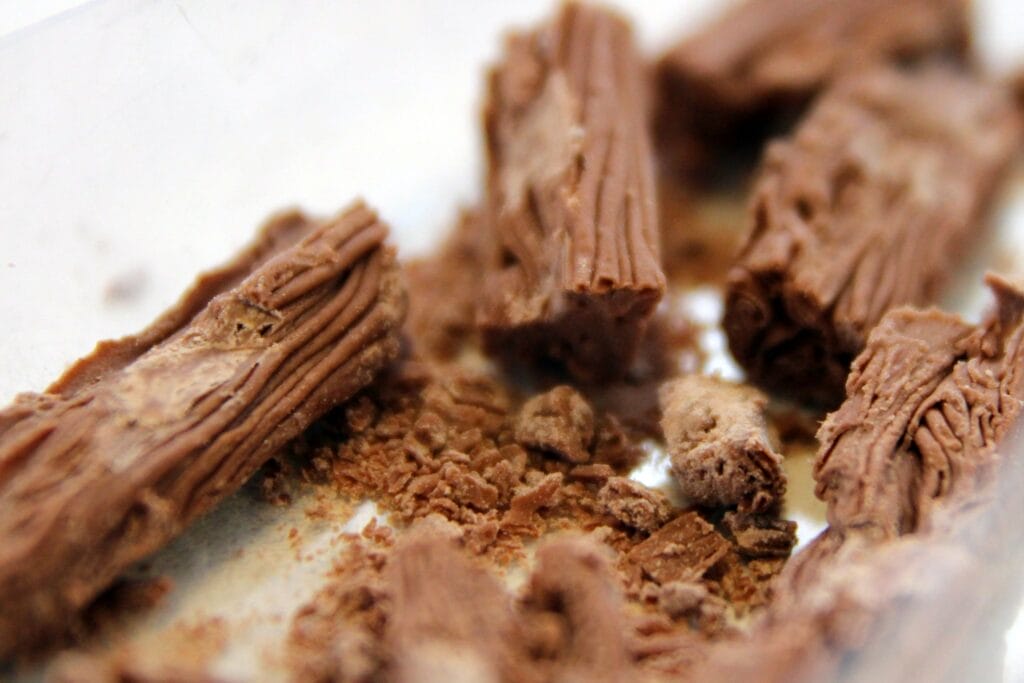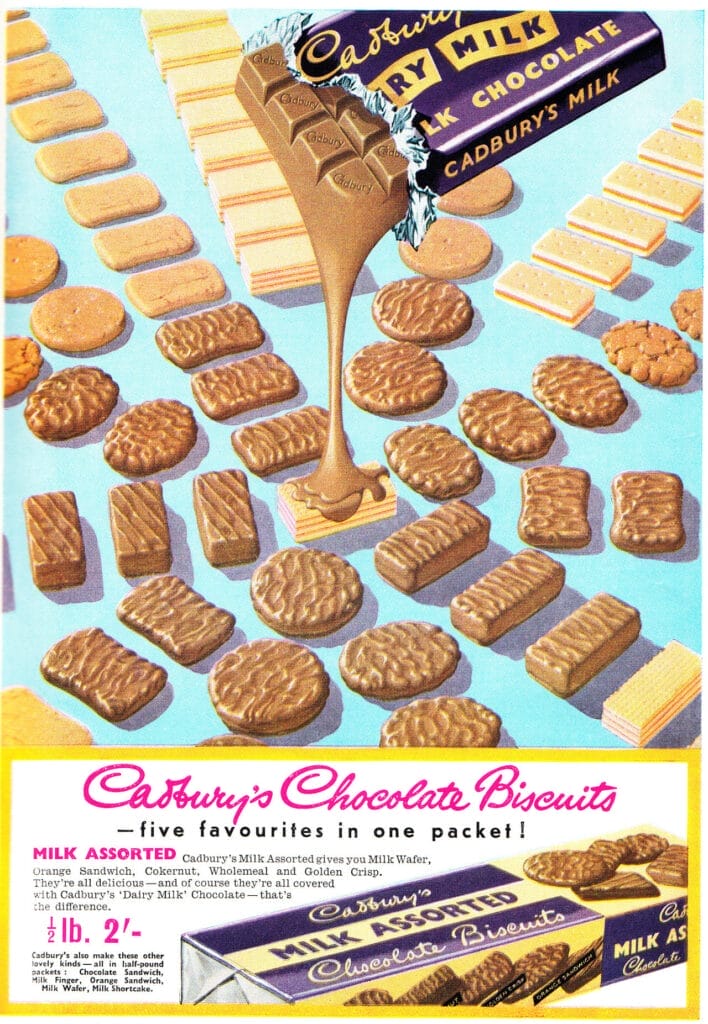This post contains affiliate links for which I may make a small commission to help keep the site running. You will not be charged extra for these items had you not clicked the links. Thank you for your help to keep the site running!
Ever heard of Cadbury chocolate?
If you’re in the UK, you definitely have!
If not, there’s still a good chance you’ve heard about this iconic British chocolate brand.
In this article, we’re uncovering things like the war of the chocolate bars in Britain, the surprising reason that Cadbury even exists in the first place, and the one place in the UK that was named by Cadburys in order to try and increase chocolate sales.

History of Cadbury Chocolate
The history of Cadbury starts with a man known as John Cadbury.
John was born in 1801 and he was a Quaker, and this was important because one of the main paths for men in the 1800s was to join the military, but Quakers generally frown upon joining the military because the faith does not support war in any form.
So, instead, he decided to open up a grocery shop in Birmingham in 1824.
The address was 93 Bull Street, and he sold many things, but was particularly known for his cocoa and drinking chocolate that he prepared himself.
At the time, he actually sold it as a health drink, with lentils or barleys mixed into it which is honestly a bold choice, can’t say it sounds interesting to me, but to each their own.
He made a great success of it, and eventually grew to 16 lines of drinking chocolate and 11 lines of Cocoa and he had to move to his first Cadbury factory in 1841.
Now fast forward a bit to John’s retirement – his sons, Richard and George, took over Cadbury, but it needed to be revitalized – and they looked to mainland Europe to figure out what to do.
At the time, there was a Dutch cocoa press, which was able to make purer cocoa butter than other machines, so they purchased one and used it to make their drinking chocolate 100% pure.
This was a huge turning point for the Cadbury brand.
The First World War starts and this means that many male Cadbury employees, over 2,000 of them, joined the British Armed Forces.
Cadbury gets involved in the war efforts by providing clothing, books, and chocolate to the troops, and suddenly the women are running the factories – nicknamed the Cadbury Angels.

Between the 2 World Wars, Cadbury grew its line of offerings even more, acquiring other companies and creating the Flake, Fruit and Nut, and Crunchies.
Another part of their success came down to their marketing of chocolate bars as items for the everyday person, including the working class.
Previously, they had been sold as “luxury items”, but Cadburys knew that chocolate was for everyone.
In World War II, Cadburys donated to the war efforts again and actually the government realized at this point that the production of Cadburys would keep morale up in the country, so chocolate was considered an essential food item for the duration of the war.
However, they did have to remove some items like Dairy milk, as fresh milk was not allowed to be used – instead turning towards ration chocolate which used dried skimmed milk.
Popular Cadbury items come along in the later half of that century, including Wispa and Crème eggs, and Cadbury World opens to the public in 1990 – prior to that, you could take a factory tour of the Cadbury’s factory, but visitors were increasing and they wanted a place specifically for visitors to learn about the chocolate making process and the brand.
In the 21st century, Cadbury’s sponsored the Olympics and has reached its 200th birthday this year.
It did become an arm of Kraft in 2010, which is controversial as many believe it’s lost much of its British ethics and roots.
How Bourneville Got Its Name

One of my absolute favorite stories about Cadbury has to do with the origin of Bourneville – you may recognize the name and have seen it on Cadbury products.
The story goes like this: in 1878, the Cadbury brothers were looking for somewhere to build a new factory for the company, but they wanted somewhere that wasn’t, in their words, “squalid and depressing.”
They needed somewhere with good transport links, a lot of room, and a place where their employees could live, work, and play together.
This dedication to employee welfare was rare for Victorian times, but the Cadburys employee enjoyed country outings and summer camps for the kids, football, hockey, and cricket teams for the workers, and it became one of the first companies to offer a Saturday half-day off work.
The area was just south of Birmingham, featuring lots of green space, and near a stream called the Bourn.
The brothers took this, then added “ville” to the end of it, which is French for town, hoping that the French-sounding name that they could now attach to their brand would make consumers believe even more highly in their quality.
So it was a factory purchase meets marketing decision meets employee retention exercise, and by all accounts, it worked.
War between British Chocolate Bars

The world’s first chocolate bar was also produced in the UK, but it wasn’t by Cadbury.
It was by a company called Fry’s, and they came out with it in 1847, being Cadbury’s top competitor at the time.
This created a sort of space race, just in chocolate form, where Cadbury then felt like they needed to keep up.
And they did, with the first Cadbury chocolate bar appearing 2 years later in 1849.
This wasn’t the first milk chocolate bar, though – that comes later, with the Cadbury Dairy Milk bar crashing onto the chocolate scene in 1905.
Whatever happened to Fry’s?
Cadbury’s won in the end, and Fry’s merged with Cadburys around 1919.
Royal Chocolate
You know a brand is loved in the UK when it has the royal stamp of approval, and Cadbury’s got just that from the monarch in 1855 when they received a Royal Warrant to take on the role of manufacturers of cocoa and chocolate to Queen Victoria.
It still holds a Royal Warrant to this day.
Cadburys Around the World
Cadburys can be found in over 50 countries, and it’s one of Britain’s most successful exports, but the main markets are the UK, Ireland, Canada, India, Australia, New Zealand, and South Africa.
Keep in mind though that formulas for the chocolate do vary based on country – you’ll notice this if you buy Cadburys chocolate in the US – even though it says Cadburys, the taste is going to be based off of local ingredients and formulas.
Cadbury in Numbers
Let’s talk some important Cadburys numbers.
There are 350 million bars of Dairy Milk chocolate sold every year.
It’s the second largest confectionary brand in the whole world, after Mars.
And 400 million chocolate buttons and 1 million crème eggs are made every single day.
Cadbury vs Cadburys

While researching this post, I kept asking myself – is it Cadbury, or Cadburys.
Turns out, they changed their name in 2003, dropping the “s”. Their explanation was that it was a more “suited, rounded name”.
Smash
Another fun fact that I learned about this iconic brand is that Cadbury once produced a brand of Instant Mashed Potatoes, known as Smash, which were launched in the 1960s.
One of the most famous Cadbury advertising campaigns of the era was actually not for chocolate, but for Smash, featuring the Smash Martians, who would watch humans preparing mashed potatoes the traditional way and then laugh at them for not using potato granules.
Cadburys Advertising

Cadbury’s Advertising overall has changed through the years, with earlier ads featuring the “health benefits of their products,” such as claiming it would improve their strength, keep the children healthy and happy, and give them a “glass and a half” of milk, which was the nutritious drink of choice in the 1920s.
They were also part of the first group of TV ads in the UK in 1955.
One of the most famous is the Gorilla ad, named as the best ad of the 200s, created more for entertainment purposes rather than the hard sale, featuring a gorilla playing the drums to the song “In the Air Tonight” by Phil Collins.
It was weird, it was memorable, and for some weird reason, people loved it and it won numerous awards.

As an Aussie I know Cadbury’s it is the chocolate I eat and yes enjoy, I found this a super interesting post learnt a fair bit which in an hour I will have forgotten as I have a shocking memory……..lol
Have you tried a Crunchie bar yet? They seem to be hard to find these days but they were always my favourite even when I was a child (and I’ll be 70 in a few weeks).
Crunchie used to be branded as Fry’s even though made by Cadbury but I don’t know if it still is. The factory near Bristol where they were made has gone now, and I think since Cadbury’s was swallowed up by Kraft all Cadbury’s stuff is made in Poland (but that’s all right because Polish chocolate is pretty good)